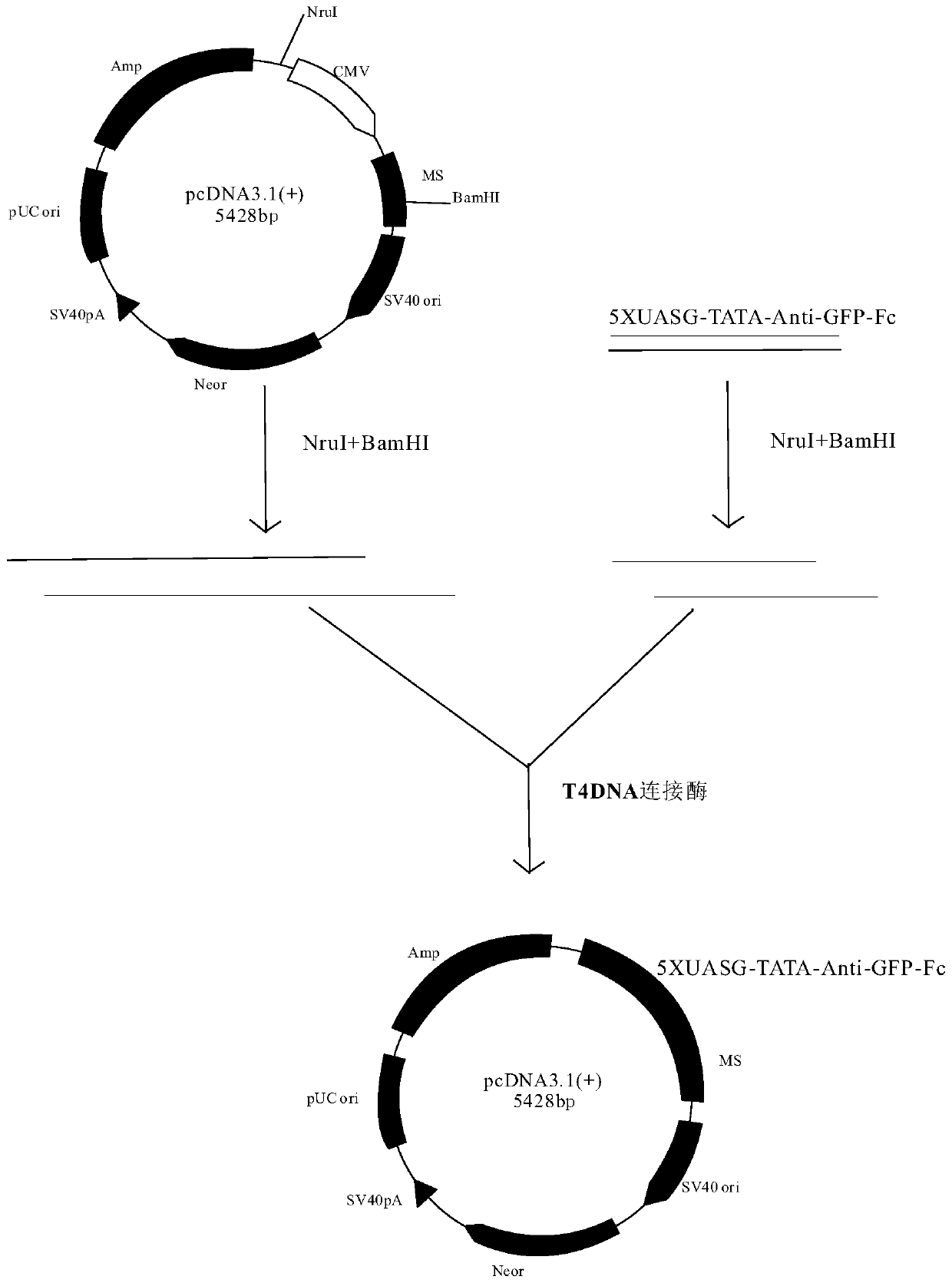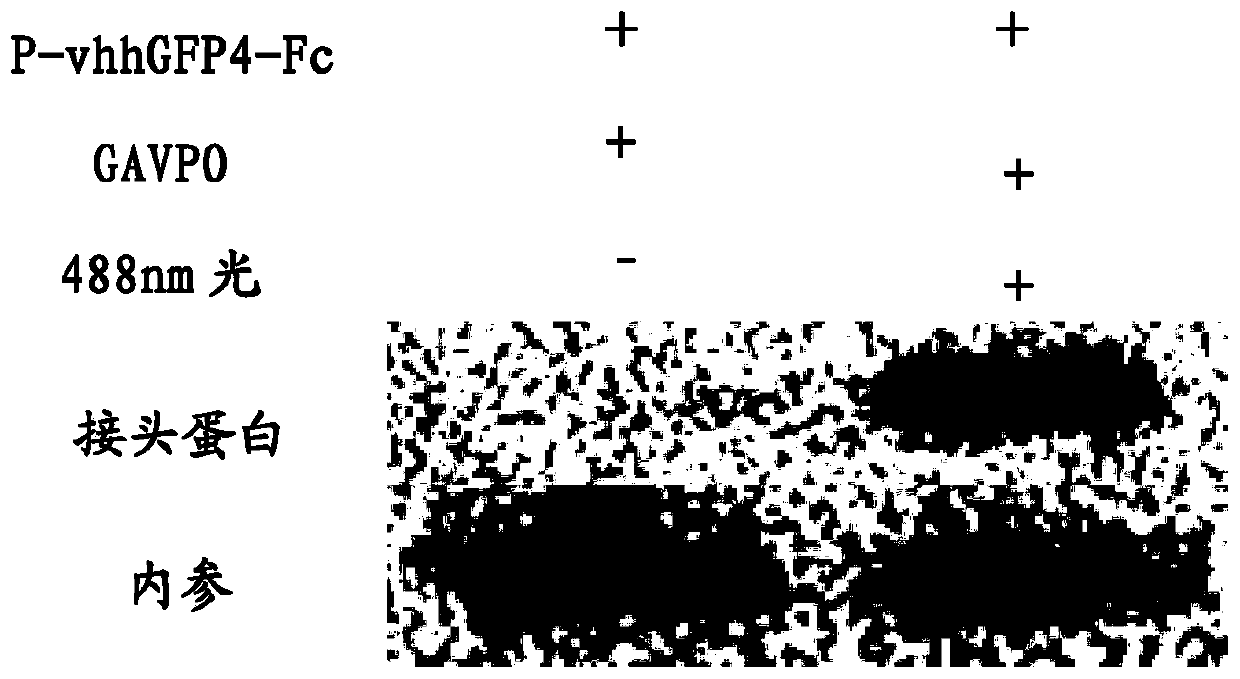Light-controlled protein degrading system and construction method, and light adjusted and controlled protein degrading method
A protein degradation and light regulation technology, applied in chemical instruments and methods, biochemical equipment and methods, cells modified by introducing foreign genetic material, etc. Issues such as lack of adjustability
- Summary
- Abstract
- Description
- Claims
- Application Information
AI Technical Summary
Problems solved by technology
Method used
Image
Examples
Embodiment 1
[0075] The construction of the light-controlled fusion protein (P-ScFv-Fc) gene sequence: taking green fluorescent protein as an example:
[0076] (1) The construction sequence of the P-vhhGFP4-Fc expression vector is SEQ.No.3, as follows:
[0077]gagtttctagacggagtactgtcctccgagcggagtactgtcctccgactcgagcggagtactgtcctccgatcggagtactgtcctccgcgaattccggagtactgtcctccgaagacgctagcggggggctataaaagggggtgggggcgttcgtcctcactctagatctgcgatctaagtaagcttggccaccatggatcaagtccaactggtggagtctggtggcgctttggtgcagccaggtggctctctgcgtttgtcctgtgccgcttctggcttcccagtgaaccgctattccatgcgctggtatcgccaggctccaggcaaagagcgtgagtgggtagccggtatgtccagcgcgggtgatcgtagctcctatgaagactccgtgaagggccgtttcaccatcagccgtgacgatgcccgtaacacggtgtatctgcaaatgaacagcttgaaacctgaagatacggccgtgtattactgtaatgtgaacgtgggcttcgagtattggggccaaggcacccaggtcaccgtctccagcgacaaaactcacacatgcccaccgtgcccagcacctgaactcctggggggaccgtcagtcttcctcttccccccaaaacccaaggacaccctcatgatctcccggacccctgaggtcacatgcgtggtggtggacgtgagccacgaagaccctgaggtcaagttcaactggtacgtggacggcgtggaggtgcataat...
Embodiment 2
[0080] To verify the efficiency of the light-controlled promoter, take green fluorescent protein as an example:
[0081] (1) Perform cell transfection experiments with P-vhhGFP4-Fc expression plasmids and GAVPO plasmids: plant the cells in a 12-well plate one day in advance, and use 25ul of serum-free medium with 1.2ug of DNA and 4ul of transfection reagent dilution. Stand at room temperature for 5 minutes; add the transfection reagent dilution to the DNA dilution, mix well, and let stand at room temperature for 15 minutes; add the transfection complex to the culture container containing cells and complete medium, and incubate for 4-6 hours Afterwards, the culture medium was replaced, and blue light (488nm, frequency 1Hz, power 0.75w) was illuminated for 24 hours, and then the cells were lysed, the protein was extracted, and the expression of the adapter protein was detected by immunoblotting under light and dark conditions. The experimental results were as follows: figure 2...
Embodiment 3
[0083] (1) Perform cell transfection experiments with P-vhhGFP4-Fc expression plasmids, GAVPO plasmids, GFP plasmids, and TRIM21 plasmids: plant cells in 12-well plates one day in advance, and use 1.2ug of DNA and 4ul of transfection reagents respectively Dilute in 25ul serum-free medium. Stand at room temperature for 5 minutes; add the transfection reagent dilution to the DNA dilution, mix well, and let stand at room temperature for 15 minutes; add the transfection complex to the culture container containing cells and complete medium, and incubate for 4-6 hours Afterwards, the medium was replaced, and the cultivation was continued for 24-48h.
[0084] (2) Set up the control group (only transfection of GFP and empty vector) and the experimental group (transfection of P-vhhGFP4-Fc plasmid, GAVPO plasmid, GFP plasmid, TRIM21 plasmid) to set up the dark group and the light group respectively, and the light group is set according to 488nm, After 24 hours of light at a frequency o...
PUM
 Login to View More
Login to View More Abstract
Description
Claims
Application Information
 Login to View More
Login to View More - R&D Engineer
- R&D Manager
- IP Professional
- Industry Leading Data Capabilities
- Powerful AI technology
- Patent DNA Extraction
Browse by: Latest US Patents, China's latest patents, Technical Efficacy Thesaurus, Application Domain, Technology Topic, Popular Technical Reports.
© 2024 PatSnap. All rights reserved.Legal|Privacy policy|Modern Slavery Act Transparency Statement|Sitemap|About US| Contact US: help@patsnap.com










